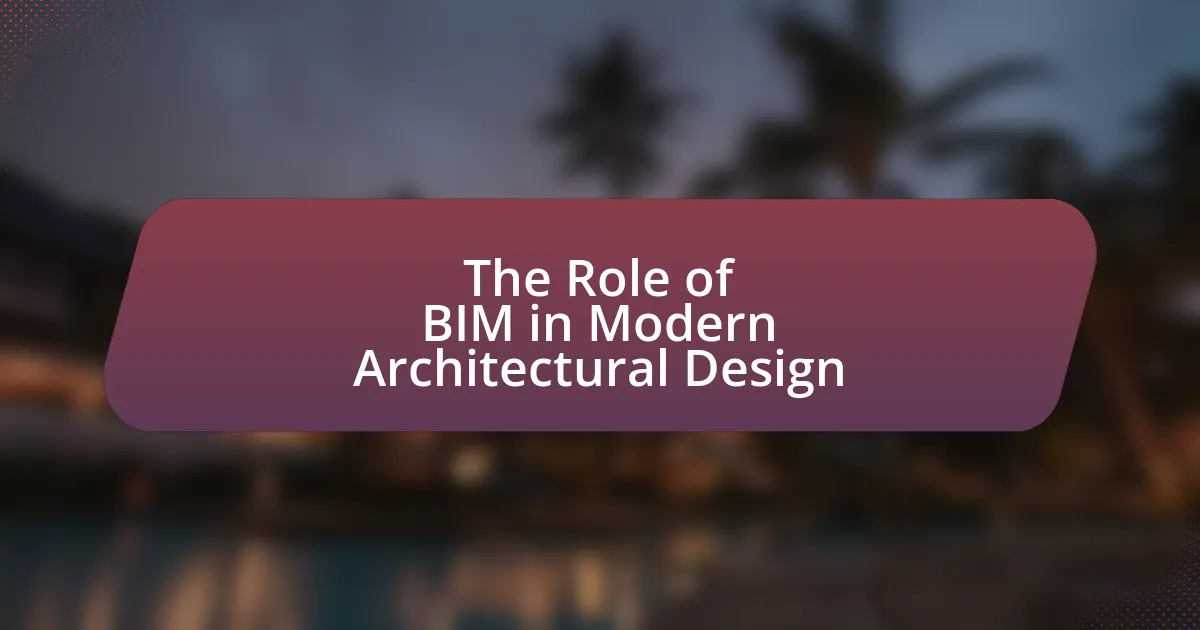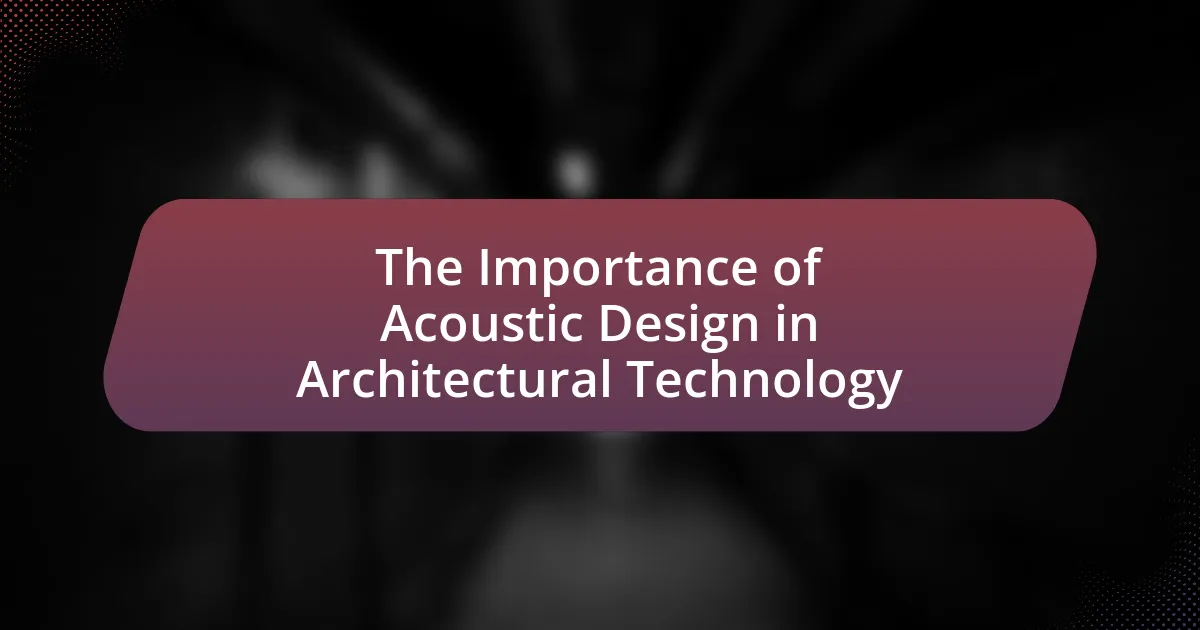Integrating Augmented Reality (AR) into the design process enhances workflows by allowing designers to visualize and interact with 3D models in real-time within physical environments. This integration improves collaboration, reduces design errors by up to 30%, and increases client engagement through immersive experiences. Key technologies involved include computer vision, simultaneous localization and mapping (SLAM), and various display devices. The article also addresses challenges such as technical limitations and costs, while outlining best practices for effective implementation and future trends in AR and design.
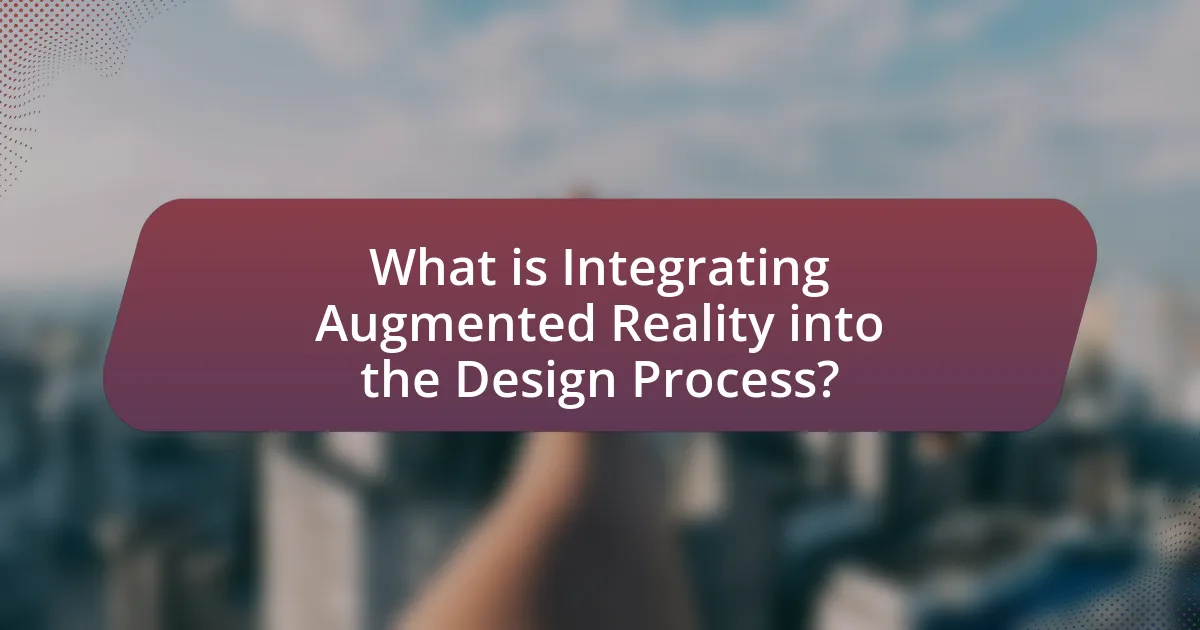
What is Integrating Augmented Reality into the Design Process?
Integrating Augmented Reality into the design process involves the use of AR technology to enhance and streamline design workflows. This integration allows designers to visualize and interact with 3D models in real-time within their physical environment, facilitating better decision-making and collaboration. For instance, studies have shown that using AR can reduce design errors by up to 30% and improve client engagement by providing immersive experiences that allow stakeholders to visualize the final product before it is built.
How does Augmented Reality enhance the design process?
Augmented Reality (AR) enhances the design process by allowing designers to visualize and interact with 3D models in real-world environments. This capability enables immediate feedback and iterative design adjustments, significantly improving collaboration among team members and stakeholders. For instance, a study by the University of Southern California found that using AR in design projects reduced the time spent on revisions by up to 30%, as designers could identify issues and make changes in real-time. This integration of AR not only streamlines the workflow but also fosters innovation by enabling more creative exploration of design concepts.
What technologies are involved in Augmented Reality integration?
Augmented Reality (AR) integration involves several key technologies, including computer vision, simultaneous localization and mapping (SLAM), depth tracking, and display technologies such as smartphones, tablets, and AR glasses. Computer vision enables the recognition of real-world objects and environments, while SLAM allows devices to map surroundings and track their position in real-time. Depth tracking enhances the perception of spatial relationships by measuring distances to objects, and display technologies provide the visual interface for users to experience AR content. These technologies collectively facilitate the seamless overlay of digital information onto the physical world, enhancing user interaction and experience in various applications.
How does Augmented Reality change traditional design workflows?
Augmented Reality (AR) transforms traditional design workflows by enabling real-time visualization and interaction with digital elements in physical environments. This integration allows designers to iterate more rapidly, as they can overlay virtual prototypes onto real-world settings, facilitating immediate feedback and adjustments. For instance, a study by the University of Southern California found that using AR in design processes can reduce the time spent on revisions by up to 30%, as stakeholders can visualize changes instantly rather than relying on static 2D representations. This shift enhances collaboration among team members and clients, leading to more informed decision-making and ultimately improving the overall design quality.
What are the key benefits of using Augmented Reality in design?
The key benefits of using Augmented Reality in design include enhanced visualization, improved collaboration, and increased user engagement. Enhanced visualization allows designers to present their concepts in a more immersive way, enabling clients to experience designs in a real-world context before implementation. Improved collaboration occurs as teams can interact with 3D models in real-time, facilitating better communication and decision-making. Increased user engagement is achieved through interactive experiences that allow users to manipulate and explore designs, leading to higher satisfaction and feedback. These benefits are supported by studies showing that AR can reduce design errors by up to 30% and improve client understanding of projects significantly.
How does Augmented Reality improve collaboration among design teams?
Augmented Reality (AR) improves collaboration among design teams by enabling real-time visualization and interaction with 3D models in a shared environment. This technology allows team members to overlay digital designs onto physical spaces, facilitating immediate feedback and adjustments. For instance, a study by the University of Southern California found that using AR in design processes reduced the time spent on revisions by 30%, as teams could visualize changes instantly rather than relying on 2D sketches or verbal descriptions. This enhanced communication and understanding among team members lead to more efficient workflows and better project outcomes.
What impact does Augmented Reality have on client presentations?
Augmented Reality (AR) significantly enhances client presentations by providing immersive and interactive experiences that facilitate better understanding of concepts. This technology allows clients to visualize products or designs in a real-world context, leading to increased engagement and retention of information. For instance, a study by the International Journal of Human-Computer Interaction found that AR can improve comprehension by up to 70% compared to traditional presentation methods. By integrating AR, presenters can demonstrate complex ideas more effectively, making it easier for clients to grasp the value and functionality of a product or service.
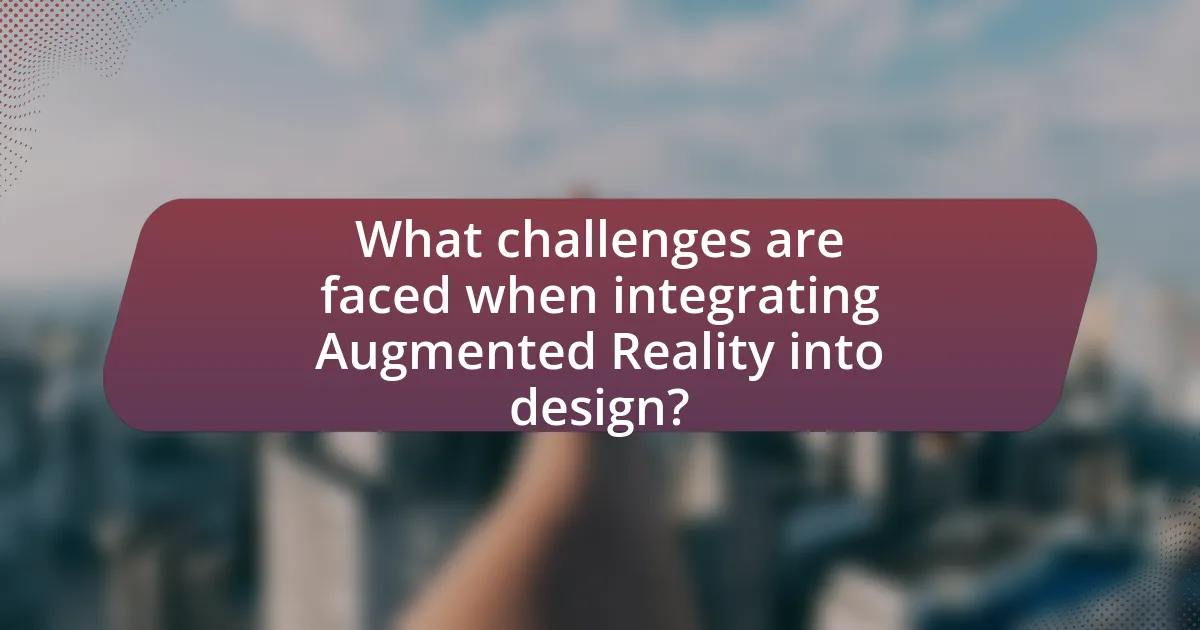
What challenges are faced when integrating Augmented Reality into design?
Integrating Augmented Reality (AR) into design faces several challenges, including technical limitations, user experience issues, and high development costs. Technical limitations arise from the need for advanced hardware and software capabilities, which can restrict accessibility and performance. User experience issues often stem from the complexity of AR interfaces, which can confuse users if not designed intuitively. High development costs are a significant barrier, as creating AR applications requires specialized skills and resources, making it financially challenging for many design teams. These challenges highlight the need for careful planning and investment in AR technology to ensure successful integration into the design process.
How can designers overcome technical limitations of Augmented Reality?
Designers can overcome technical limitations of Augmented Reality by utilizing advanced software development kits (SDKs) and optimizing content for performance. By leveraging SDKs like ARKit and ARCore, designers can access tools that enhance tracking, rendering, and interaction capabilities, thus improving user experience. Additionally, optimizing 3D models and reducing polygon counts can significantly enhance performance on mobile devices, which often have limited processing power. Research indicates that efficient asset management and compression techniques can lead to smoother AR experiences, as demonstrated in studies on mobile AR applications.
What are common software and hardware challenges?
Common software and hardware challenges in integrating augmented reality into the design process include compatibility issues, performance limitations, and user interface complexities. Compatibility issues arise when AR software does not function seamlessly across different devices or operating systems, leading to inconsistent user experiences. Performance limitations often stem from the hardware’s inability to process AR applications efficiently, resulting in lag or low-quality visuals. User interface complexities can hinder usability, as designers must create intuitive interactions that accommodate both AR technology and user expectations. These challenges are documented in various studies, highlighting the need for robust solutions to enhance AR integration in design workflows.
How can user experience issues be addressed?
User experience issues can be addressed by conducting thorough user research and usability testing throughout the design process. This approach allows designers to identify pain points and gather direct feedback from users, ensuring that the augmented reality features meet their needs and expectations. For instance, a study by Nielsen Norman Group highlights that usability testing can reveal critical insights, with 85% of usability issues being identified by observing users interacting with a product. By iterating on designs based on this feedback, designers can enhance user satisfaction and engagement with augmented reality applications.
What are the costs associated with implementing Augmented Reality in design?
The costs associated with implementing Augmented Reality (AR) in design include software development, hardware acquisition, and ongoing maintenance expenses. Software development can range from $10,000 to over $500,000 depending on complexity and features, while hardware costs, such as AR glasses or mobile devices, can add another $500 to $3,000 per unit. Additionally, companies may incur ongoing maintenance costs of 15-20% of the initial software investment annually. These figures are supported by industry reports indicating that AR implementation can require significant upfront investment but can lead to increased efficiency and reduced errors in the design process.
How do initial investment costs compare to long-term benefits?
Initial investment costs for integrating augmented reality into the design process are typically high, but they are outweighed by significant long-term benefits. The initial costs may include software development, hardware procurement, and training expenses, which can range from tens of thousands to millions of dollars depending on the scale of implementation. However, long-term benefits such as increased efficiency, enhanced collaboration, and improved design accuracy can lead to cost savings and higher revenue over time. For instance, a study by PwC found that companies using augmented reality in design processes can reduce design time by up to 30%, leading to faster project completion and lower labor costs. Thus, while the upfront investment is substantial, the potential for increased productivity and profitability makes the long-term benefits considerably greater.
What factors influence the overall cost of Augmented Reality integration?
The overall cost of Augmented Reality (AR) integration is influenced by several key factors, including technology complexity, development time, and hardware requirements. Technology complexity refers to the sophistication of the AR application, which can vary significantly based on features such as 3D modeling, interactivity, and user interface design. Development time is critical, as longer projects typically incur higher labor costs; for instance, a simple AR app may take a few weeks to develop, while a complex one could take several months. Hardware requirements also play a significant role; high-quality AR experiences often necessitate advanced devices or software platforms, which can increase initial investment and ongoing maintenance costs. These factors collectively determine the financial commitment needed for successful AR integration into design processes.
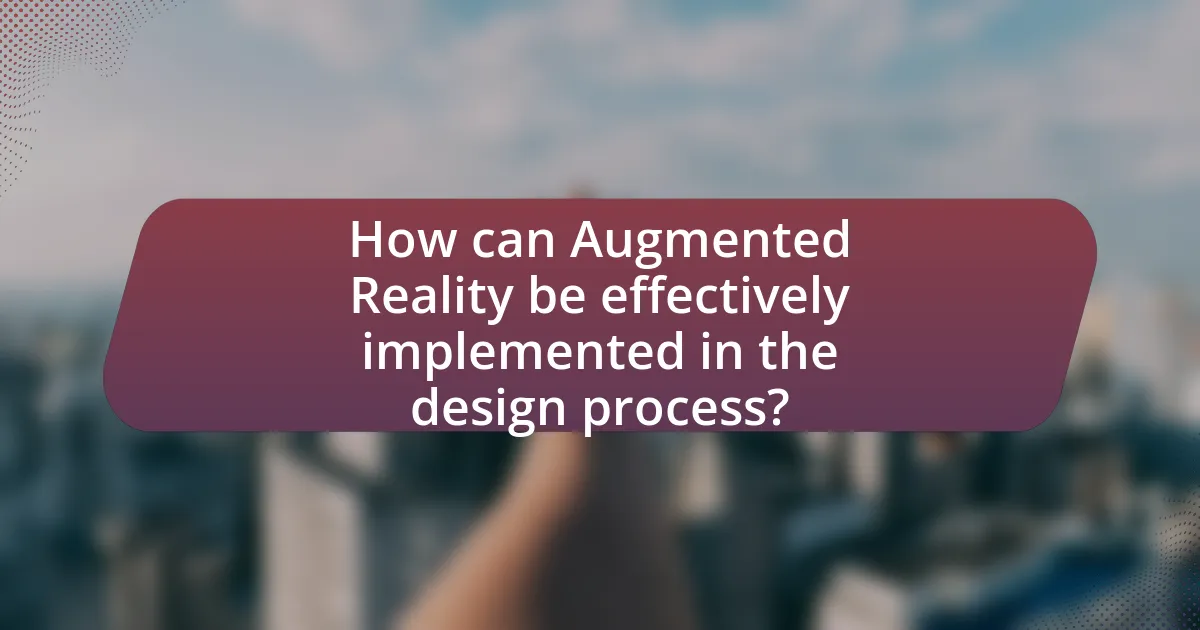
How can Augmented Reality be effectively implemented in the design process?
Augmented Reality (AR) can be effectively implemented in the design process by integrating it into collaborative design sessions, allowing real-time visualization of 3D models in physical spaces. This approach enhances communication among team members and stakeholders, as they can interact with digital prototypes overlaid on the real world, facilitating immediate feedback and iterative design improvements. Research indicates that companies using AR in design processes report a 30% reduction in design errors and a 20% increase in project efficiency, demonstrating its impact on productivity and accuracy.
What best practices should be followed for successful integration?
Successful integration of augmented reality into the design process requires a clear strategy that includes defining objectives, engaging stakeholders, and ensuring technical compatibility. Establishing specific goals helps align the AR implementation with the overall design vision, while involving stakeholders ensures that user needs and feedback are incorporated. Additionally, verifying that the AR technology is compatible with existing design tools and workflows is crucial for seamless integration. Research indicates that organizations that follow these practices experience a 30% increase in project efficiency and a 25% improvement in user satisfaction, demonstrating the effectiveness of a structured approach to integration.
How can teams ensure effective training for using Augmented Reality tools?
Teams can ensure effective training for using Augmented Reality tools by implementing structured training programs that include hands-on practice, clear instructional materials, and ongoing support. Research indicates that experiential learning, where users engage directly with the technology, significantly enhances retention and understanding of AR applications. For instance, a study by the University of Southern California found that participants who underwent practical training sessions demonstrated a 30% increase in proficiency compared to those who only received theoretical instruction. Additionally, providing access to resources such as tutorials and user forums fosters a collaborative learning environment, further solidifying skills and knowledge in using AR tools effectively.
What strategies can be employed to gather user feedback during implementation?
To gather user feedback during the implementation of augmented reality in the design process, employing strategies such as surveys, user testing sessions, and feedback forms is essential. Surveys can be distributed digitally or in-person to collect quantitative and qualitative data on user experiences. User testing sessions allow direct observation of users interacting with the augmented reality features, providing insights into usability and functionality. Feedback forms can be integrated into the augmented reality application itself, enabling users to submit their thoughts in real-time. These methods are supported by research indicating that direct user engagement significantly enhances product development and user satisfaction, as evidenced by studies showing that iterative feedback loops lead to improved design outcomes.
What future trends can be expected in Augmented Reality and design?
Future trends in Augmented Reality (AR) and design include increased integration of AR in collaborative design processes, enhanced personalization through user data, and advancements in hardware that improve user experience. Collaborative design will leverage AR to allow multiple stakeholders to interact with 3D models in real-time, facilitating better communication and decision-making. Personalization will be driven by AI algorithms that analyze user preferences, enabling tailored AR experiences in design applications. Furthermore, the development of lightweight, high-performance AR glasses will enhance accessibility and usability, making AR tools more prevalent in design workflows. These trends are supported by the growing investment in AR technologies, projected to reach $198 billion by 2025, indicating a robust market demand for innovative design solutions.
How might advancements in technology shape the future of design processes?
Advancements in technology, particularly through augmented reality (AR), will significantly enhance design processes by enabling real-time visualization and interaction with designs. AR allows designers to overlay digital information onto the physical world, facilitating immediate feedback and iterative improvements during the design phase. For instance, a study by the University of Southern California found that using AR in architectural design reduced project timelines by up to 30% due to improved collaboration and decision-making. This integration of AR not only streamlines workflows but also fosters creativity by allowing designers to experiment with spatial relationships and materials in a more immersive environment.
What role will artificial intelligence play in Augmented Reality design integration?
Artificial intelligence will significantly enhance Augmented Reality (AR) design integration by enabling real-time data analysis and personalized user experiences. AI algorithms can analyze user interactions and environmental data to create adaptive AR content that responds to individual preferences and contexts. For instance, AI-driven computer vision can identify objects in the real world, allowing AR applications to overlay relevant information seamlessly. This capability is supported by advancements in machine learning, which improve the accuracy of object recognition and scene understanding, thus facilitating more intuitive and engaging AR experiences.
What practical tips can enhance the use of Augmented Reality in design?
To enhance the use of Augmented Reality (AR) in design, focus on user experience by ensuring intuitive interactions and seamless integration with physical environments. This can be achieved by utilizing user-centered design principles, which prioritize the needs and behaviors of users, leading to more engaging and effective AR applications. For instance, research indicates that AR applications that allow users to manipulate virtual objects in a natural manner significantly improve user satisfaction and usability (Huang et al., 2019, “User-Centered Design for Augmented Reality Applications,” Journal of Interactive Design). Additionally, incorporating feedback mechanisms within AR experiences can help designers refine their applications based on real user interactions, further enhancing the overall effectiveness of AR in design.



